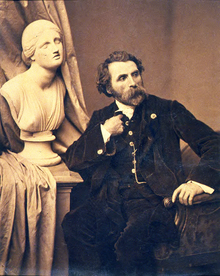Antoine Samuel Adam-Salomon
| Antoine Samuel Adam-Salomon | |
|---|---|

Self-portrait, c. 1860
|
|
| Born |
9 January 1818 La Ferté-sous-Jouarre, Seine-et-Marne, France |
| Died | 28 April 1881 (aged 63) Paris, France |
| Resting place | Fontainebleau |
| Other names | Exhibited in the Salon as "Adama" (1844 and 1848). |
| Occupation | Sculptor, Portrait Photographer |
| Organization | Société Française de Photographie |
| Spouse(s) | Georgine Cornélie Coutellier |
| Awards | Légion d’honneur, 1870 |
Antoine Samuel Adam-Salomon (9 January 1818 – 28 April 1881 ) was a French sculptor and photographer.
Antoine Samuel Adam-Salomon was born to a French Jewish family on 9 January 1818 in La Ferté-sous-Jouarre, Seine-et-Marne, France. Following a brief career as a modeler for the Jacob Petit pottery factory in Fontainebleau, he received a scholarship to study sculpture in Paris. He also traveled for studies to Switzerland and England. His notable sculptures include busts of Victor Cousin, Odilon Barrot, Pierre-Jean de Béranger, Alphonse de Lamartine, Gioachino Rossini, and Marie Antoinette.
After becoming established as a sculptor, Adam-Salomon studied photography under the portraitist Franz Hanfstaengl in Munich in 1858. He became a leading portrait photographer. Adam-Salomon returned to Paris where he opened a portrait studio in 1859; in 1865 he opened a second Paris studio. In 1870 Adam-Salomon was made a member of the Société française de photographie and received the Légion d’honneur the same year. Adam-Salomon's portrait photographs were considered to be among the best existing works during his lifetime, and were renowned for their chiaroscuro produced by special lighting techniques.
The photography of Adam-Salomon played a pivotal role in the mainstream acceptance of photography as an art form. For example, in 1858 the poet Alphonse de Lamartine described photography as "this chance invention which will never be art, but only a plagiarism of nature through a lens." A short time later, after seeing the photographs by Adam-Solomon, Lamartine changed his opinion.
Coverage of Salomon's work in the French press outnumbered that of Félix Nadar by a ratio of ten to one. After the Paris Exposition of 1867, the reviewer for The Times (UK) described Salomon's pictures "matchless", "beyond praise," "the finest photographic portraits in the world."
...
Wikipedia
